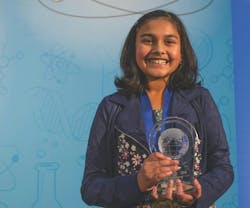Q&A: Gitanjali Rao - Time Magazine's 2020 Kid Of The Year
Gitanjali Rao is a sixth grade student at STEM School Highlands Ranch. Kathleen Shafer is a research specialist in the Corporate Research Materials Laboratory at 3M. For more information about the Discovery Education 3M Young Scientist Challenge, email [email protected].
undefinedIt can be a struggle to get young people in the water industry, but sometimes there are exceptions. The Discovery Education 3M Young Scientist Challenge asks students in fifth through eighth grade to identify and solve a problem using science. Gitanjali Rao, an 11-year-old from Lone Tree, Colo., won the 2017 competition with the help of her scientist mentor Kathleen Shafer, research specialist in the corporate research materials laboratory at 3M. Rao's winning invention was Tethys, a mobile system that speeds up the process of lead detection in drinking water. WQP Managing Editor Amy McIntosh asked Rao and Shafer more about the project.
Amy McIntosh: What inspired you to create a lead detection device?
Gitanjali Rao: The water crisis in Flint, Michigan, and my research on the current methods of testing water quality both inspired me to come up with a solution.
McIntosh: Please describe your research process.
Rao: I started my research by reading articles about the problems with lead in water. As I understood more about the health effects of lead, especially in young children, I started finding out if the residents in Flint could have found out their water quality themselves. It was appalling to find out that there were no easy ways. You either had to send a water sample to specialized labs or depend on some strips. For taking water samples, you had to not use your water for hours. It was very time consuming and inconvenient. Today's solutions were more cumbersome or inaccurate. The solutions looked at accuracy and detection independently.
I wanted a solution that easily not only detects [lead], but also [tells] us the amount of lead in [water] to understand if it's safe for the consumers of [if we] should instantly notify authorities.
Once I knew the current gaps, I connected [them] with some technologies that I learned about. I always keep myself up to date on [the] latest updates in technologies and some of those started looking promising. I used the experimentation and building phase to then come up with the device.
McIntosh: How Does the Tethys device work?
Rao: The product has three parts: a core processor, a disposable [carbon nanotube (CNT)] cartridge and a smartphone. The core processor uses a battery and completes an electrical circuit with the cartridge. When the cartridge is dipped in contaminated water, a chlorine-doped CNT that is present in the cartridge reacts with lead compounds, such as lead acetate, in contaminated water to form lead chloride molecules in the CNT. This adds resistance to the circuit that is measured by the core processor and [passes] to the mobile app via Bluetooth. The mobile app displays results based on the intensity of lead in the water. [This happens] almost instantaneously. For a new test, a new cartridge is inserted.
McIntosh: What kind of guidance did you provide?
Kathleen Shafer: The top 10 innovations in the 2017 Discovery Education 3M Young Scientist Challenge are initiated and driven by the student finalists. As mentors, our role is to support them, help them plan for success, and serve as a sounding board and resource when they encounter setbacks. Anjali and I connected by phone and Skype during the summer where we would discuss her progress, roadblocks and upcoming plans.
McIntosh: What did you learn from this experience?
Shafer: In addition to learning about Arduinos, resistors and drinking water testing/standards, I learned that Gitanjali is incredibly passionate about using science to make a difference. She took on a very challenging project this summer and really drove its progress with tenacity and determination. I'm so excited to see where her curiosity and diverse talents will take her in the future, both in her career and broader pursuits.
Editor's Note: On December 3, 2020, Gitanjali Rao was named Time Magazine's first-ever "Kid of the Year." Read that feature and an update on Rao. Read WQP's reporting on the event here.
Related Content:
- On the Horizon—December 2017 editorial letter unpacks this above Q&A
- Submit nominations for WQP's Young Professional program
